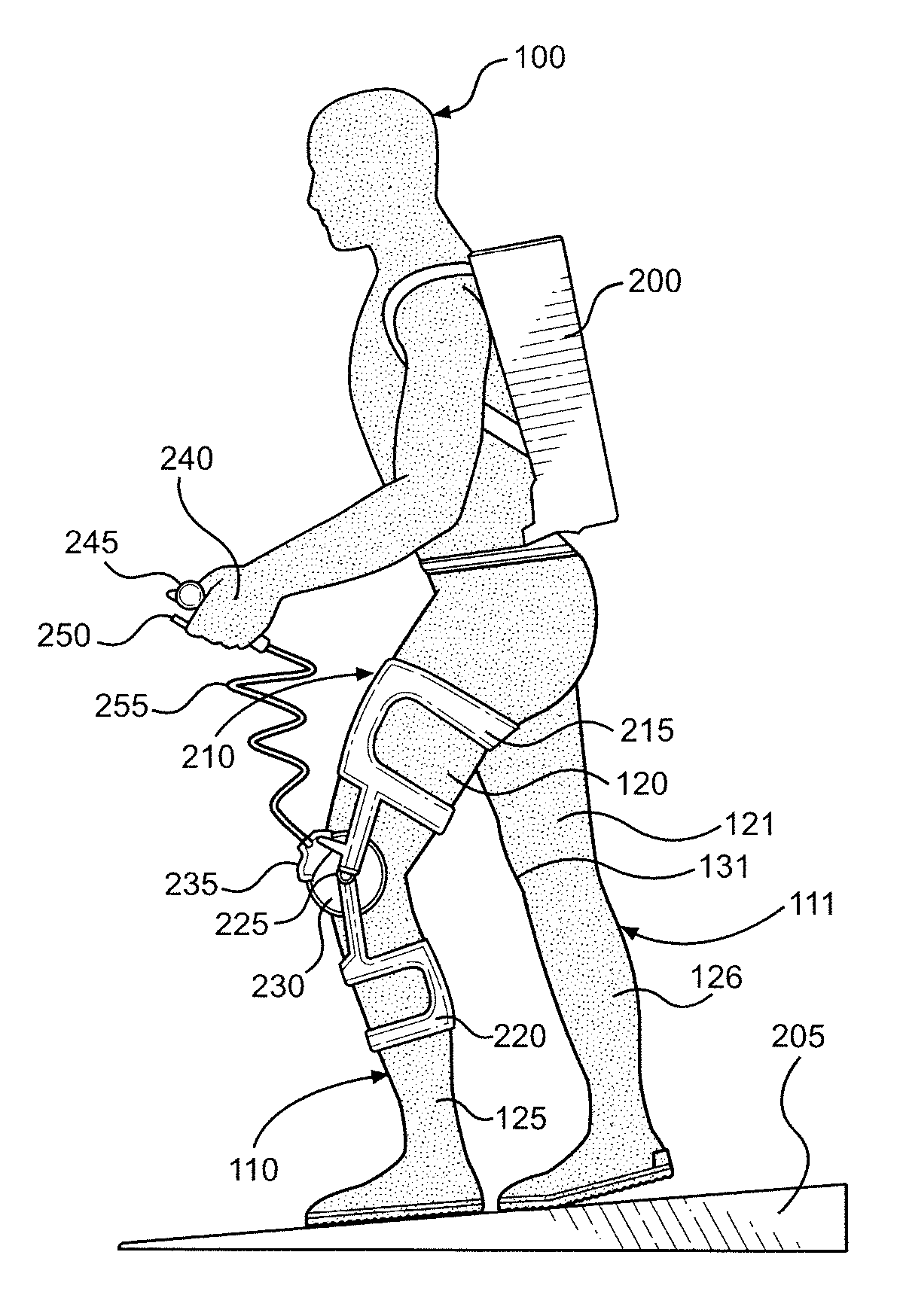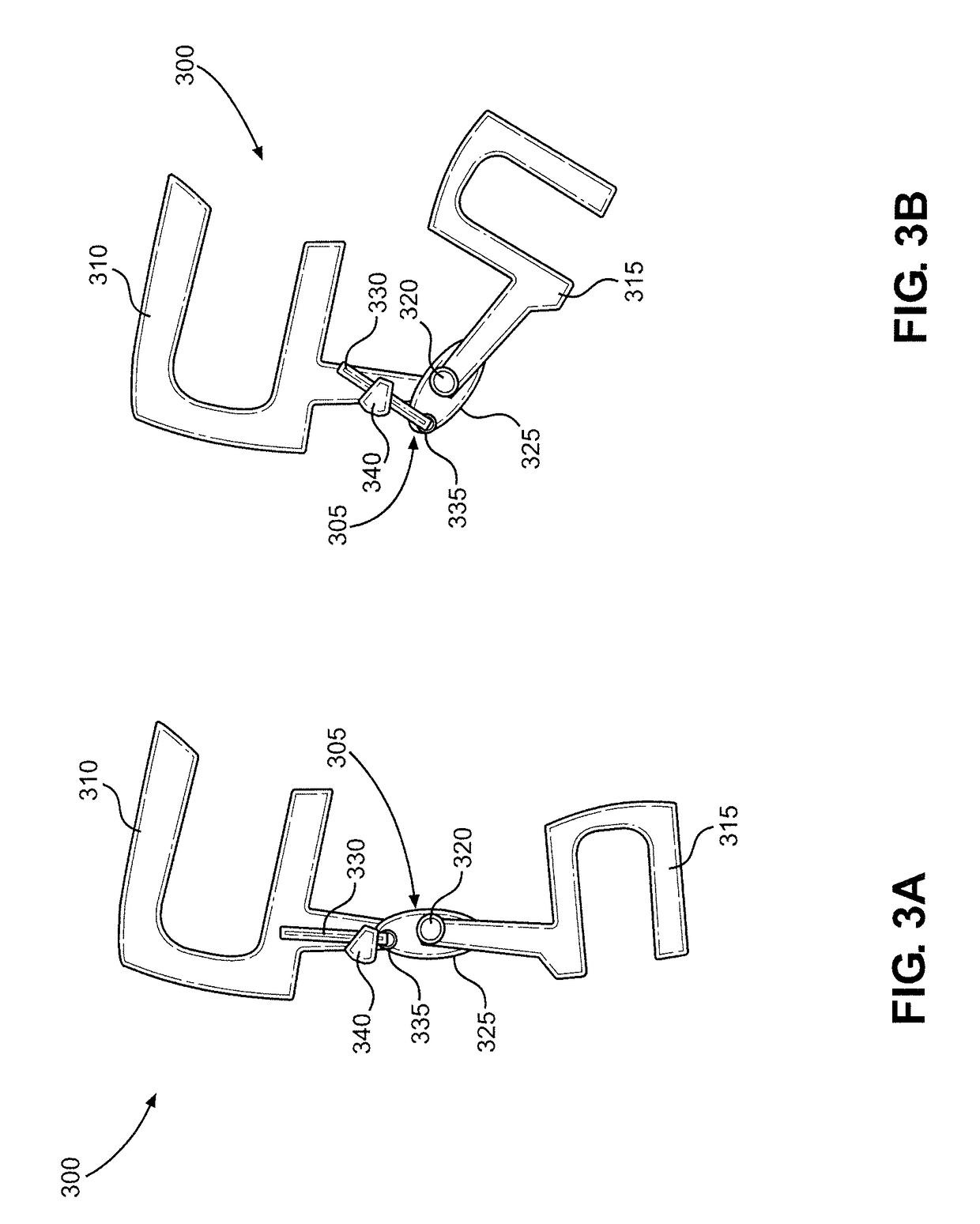Exoskeleton Device and Method of Impeding Relative Movement in the Exoskeleton Device
a technology of exoskeleton and relative movement, which is applied in the field of exoskeleton device and relative movement impedance in the exoskeleton device, can solve the problems of knee being completely locked, human legs not having continuous motion,
- Summary
- Abstract
- Description
- Claims
- Application Information
AI Technical Summary
Benefits of technology
Problems solved by technology
Method used
Image
Examples
first embodiment
[0024]With reference now to FIG. 2, the present invention is illustrated. Person 100, wearing a backpack 200, is walking downhill on a surface 205. An exoskeleton device 210 is fitted to leg 110 of person 100. A thigh brace 215 of exoskeleton device 210 is coupled to upper leg 120 of person 100, and shank brace 220 of exoskeleton device 210 is coupled to lower leg 125 of person 100. Exoskeleton device 210 rotates at an exoskeleton knee joint 225, which is collocated with knee 130 of leg 110. A rotor 230 is attached to shank brace 220 and rotates about exoskeleton knee joint 225. The rotation of rotor 230 and exoskeleton knee joint 225 is limited by the action of a caliper 235. Caliper 235 is attached to thigh brace 215, with caliper 235 in close proximity to and selectively interacting with rotor 230. Person 100 controls the action of caliper 235 by using a hand 240 to squeeze a handbrake body 245 and a handbrake lever 250 to transmit a force through a brake line 255 to caliper 235....
second embodiment
[0027]Turning to FIGS. 3A and 3B, the present invention is illustrated. FIG. 3A shows an exoskeleton device 300, equipped with a linear braking device 305, in a fully extended knee position, and FIG. 3B shows exoskeleton device 300 in a flexed knee position. As with exoskeleton device 210, exoskeleton device 300 is comprised of a thigh brace 310 that is rotatably connected to a shank brace 315 at an exoskeleton knee joint 320. Shank brace 315 is connected to a shank extension 325, and a linear brake shoe 330 is connected to shank extension 325 by a pivot joint 335. Linear brake shoe 330 passes through and in close proximity with a caliper 340. Caliper 340 is connected to thigh brace 310 and selectively interacts with linear brake shoe 330. Specifically, the person wearing exoskeleton device 300 controls the action of caliper 340 by using a handbrake or other device, as discussed above in connection with FIG. 2. As caliper 340 engages, or contacts, linear brake shoe 330, the rotation...
fourth embodiment
[0031]With reference now to FIG. 5A, the present invention is illustrated. Person 100, who is wearing backpack 200, is walking downhill on surface 205. The downward force exerted by the weight of backpack 200 is represented by dotted arrow 400. An exoskeleton device 500 is fitted to legs 110 and 111 of person 100 although, for simplicity, only the portion of exoskeleton device 500 fitted to leg 110 is described below. A thigh brace 505 of exoskeleton device 500 is coupled to upper leg 120 of person 100, and thigh link 510 is connected to thigh brace 505. Thigh link 510 is rotatably connected to an exoskeleton hip joint 515, with exoskeleton hip joint 515 rotatably connected to a hip-backpack connection 520. Hip-backpack connection 520 is coupled to belt 425 of backpack 200 at a thigh-backpack connection 525 on hip 435 of person 100. Thigh brace 505 of exoskeleton device 500 is rotatably coupled to an exoskeleton knee joint 530, and exoskeleton knee joint 530 is also rotatably couple...
PUM
 Login to View More
Login to View More Abstract
Description
Claims
Application Information
 Login to View More
Login to View More - R&D
- Intellectual Property
- Life Sciences
- Materials
- Tech Scout
- Unparalleled Data Quality
- Higher Quality Content
- 60% Fewer Hallucinations
Browse by: Latest US Patents, China's latest patents, Technical Efficacy Thesaurus, Application Domain, Technology Topic, Popular Technical Reports.
© 2025 PatSnap. All rights reserved.Legal|Privacy policy|Modern Slavery Act Transparency Statement|Sitemap|About US| Contact US: help@patsnap.com



